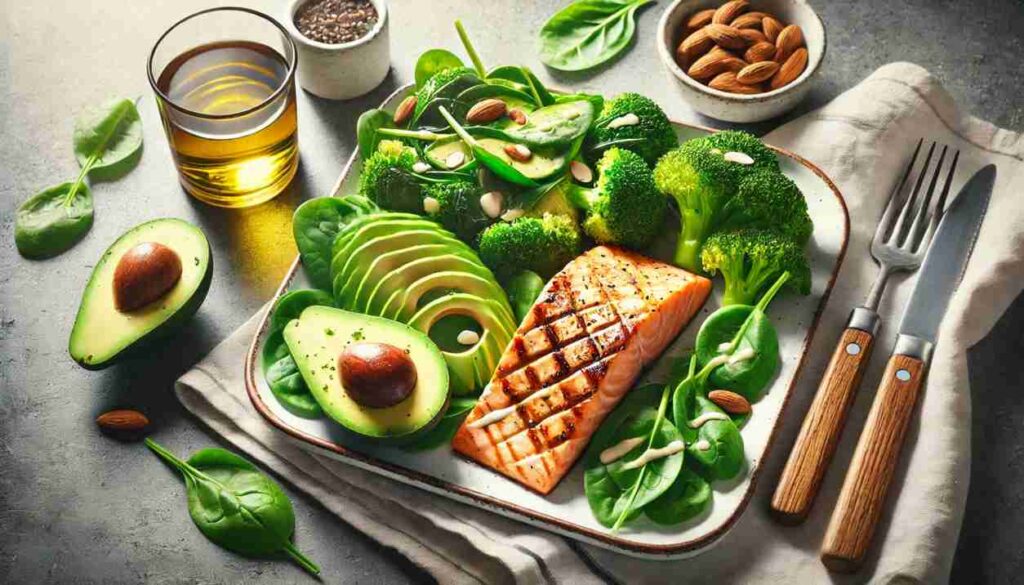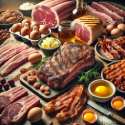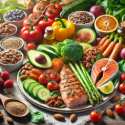
Our product evaluations are completely independent and free from advertisements. Should you make a purchase via the links on our website, we might receive a small commission, which is a key support for our review process. For more details, click here.
Low-carb, high-fat (LCHF) diets have garnered significant attention for their potential benefits in weight loss, improved metabolic health, and sustained energy. These diets generally focus on reducing carbohydrate intake and increasing healthy fats, leading to a shift in the body’s energy source from glucose (carbs) to fat, often resulting in a state known as ketosis. By altering the body’s fuel source, LCHF diets can have profound impacts on weight management, blood sugar regulation, and even cognitive function.
In this guide, we will explore some of the most popular low-carb, high-fat diets, including their unique features, benefits, and potential challenges. Whether you’re looking to adopt a low-carb diet for weight loss or overall wellness, this article will provide valuable insights into which diet might work best for you.
And if you wish to explore more diets, check out our top diets list here.
How to Choose the Right Low-Carb/High-Fat Diet for You?
Low-carb, high-fat diets come in many varieties, each with its own unique approach to reducing carbohydrate intake and increasing healthy fats. Whether you’re drawn to the strictness of the keto diet, the phased flexibility of Atkins, or the heart-healthy focus of Mediterranean keto, there is likely an LCHF diet that aligns with your health goals and lifestyle.
Who Are These Diets For?
- People Looking to Lose Weight: The quick fat-burning effects of many LCHF diets make them popular among those seeking to shed pounds.
- Individuals with Metabolic or Blood Sugar Issues: Many LCHF diets help regulate blood sugar, making them beneficial for individuals with insulin resistance or type 2 diabetes.
- Those Seeking Cognitive Clarity: The high fat content, particularly in keto and Bulletproof diets, is linked to improved cognitive function and mental clarity.
Things to Keep in Mind
- Individualization: Not all LCHF diets work for everyone. Some people thrive on the stricter ketogenic diet, while others need the flexibility of plans like Atkins or South Beach. It’s important to experiment with what works for your body.
- Focus on Quality: While these diets encourage high fat consumption, it’s essential to focus on quality fats such as olive oil, avocado, and nuts, and avoid processed and trans fats.
1. Keto Diet
Key Features

The ketogenic diet, or keto for short, is one of the most well-known LCHF diets. It focuses on drastically reducing carbohydrate intake to around 5-10% of daily calories, with fat making up about 70-75%, and protein filling the rest. By doing so, the body enters ketosis, a state where it burns fat for fuel instead of carbohydrates.
Health Benefits
- Weight Loss: The keto diet is highly effective for rapid fat loss, as the body becomes efficient at burning fat.
- Improved Blood Sugar Control: For those with insulin resistance or type 2 diabetes, keto can help stabilize blood sugar levels.
- Increased Mental Clarity: Many people report better focus and cognitive function on keto due to the steady supply of energy from fats.
Potential Challenges
The restrictive nature of keto can make it difficult to maintain, especially in social settings where carbs are common. It’s also important to ensure that the fats consumed are healthy sources like avocado, nuts, seeds, and olive oil, rather than processed or trans fats.
2. Atkins Diet
Key Features
The Atkins diet is another well-known low-carb diet, divided into four phases: induction, balancing, fine-tuning, and maintenance. The induction phase is the most restrictive, allowing only 20 grams of net carbs per day, while the later phases gradually reintroduce more carbs based on individual tolerance levels.
Health Benefits
- Sustainable Weight Loss: The phased approach allows for gradual adaptation, making it easier to maintain over the long term.
- Appetite Control: Like keto, the Atkins diet helps control hunger by focusing on high-fat, high-protein foods.
Potential Challenges
The later phases of the Atkins diet may lead to overeating carbohydrates for some individuals, slowing progress. Additionally, those with certain medical conditions should consult a healthcare provider before starting.
3. South Beach Diet
Key Features
The South Beach Diet is a modified low-carb diet that encourages lean proteins, healthy fats, and high-fiber carbohydrates. Unlike the strict carb-cutting seen in keto or Atkins, South Beach focuses on the quality of carbohydrates, promoting whole grains and vegetables.
Health Benefits
- Heart Health: By promoting healthy fats like olive oil and nuts, South Beach is designed to improve cholesterol levels and heart health.
- Balanced Nutrition: This diet allows for a broader range of foods than more restrictive LCHF diets, making it more sustainable for long-term use.
Potential Challenges
Though less restrictive, some may struggle with the limits on saturated fats and processed carbs, especially in the early phases of the diet.
4. Zone Diet
Key Features

The Zone Diet balances macronutrient intake, aiming for 40% carbohydrates, 30% protein, and 30% fat at each meal. It focuses on controlling insulin levels by eating small, balanced meals throughout the day, with an emphasis on low-glycemic carbohydrates.
Health Benefits
- Weight Loss: The Zone Diet’s balanced macronutrient ratios help regulate hunger and maintain steady energy levels.
- Anti-inflammatory Effects: By focusing on lean proteins, healthy fats, and non-starchy vegetables, the Zone Diet may reduce inflammation.
Potential Challenges
The complexity of meal planning and calculating macronutrient ratios can be challenging for some people, making it harder to stick with the diet over time.
5. Low-Carb Diet
Key Features
A general low-carb diet reduces carbohydrate intake but does not adhere to a specific ratio of macronutrients like keto or Atkins. It encourages the consumption of proteins and fats from both animal and plant sources, while limiting sugar, grains, and starchy vegetables.
Health Benefits
- Flexibility: This diet offers more flexibility than other LCHF diets, allowing individuals to tailor their carb intake based on personal goals and tolerance.
- Blood Sugar Control: Reducing carb intake can help manage blood sugar and insulin levels.
Potential Challenges
Without specific guidelines, a low-carb diet may lead to inconsistent results if individuals are unsure of how many carbs they should consume.
6. Mediterranean Keto Diet
Key Features
The Mediterranean Keto Diet combines the principles of the ketogenic diet with the heart-healthy Mediterranean diet. It emphasizes high-quality fats like olive oil, fish, and nuts, while still keeping carbohydrates very low.
Health Benefits
- Heart Health: The emphasis on omega-3-rich fish and olive oil promotes heart health while still maintaining the benefits of ketosis.
- Weight Loss and Longevity: This diet supports fat loss and has potential longevity benefits thanks to its focus on nutrient-rich foods.
Potential Challenges
This diet can be more expensive to maintain due to the emphasis on high-quality fats and seafood.
7. Dukan Diet
Key Features
The Dukan Diet is a high-protein, low-carb diet divided into four phases: attack, cruise, consolidation, and stabilization. It restricts carbs heavily in the first two phases, with more variety introduced in the later phases.
Health Benefits
- Rapid Weight Loss: The high-protein content helps reduce hunger and promotes quick weight loss in the early phases.
- Muscle Retention: The focus on lean protein helps preserve muscle mass while losing fat.
Potential Challenges
The Dukan Diet can be highly restrictive, especially in the early phases, making it difficult to follow for long periods. Additionally, the lack of dietary fats may cause fatigue or nutrient deficiencies in some individuals.
8. Carnivore Diet
Key Features

The Carnivore Diet is the most extreme form of low-carb, high-fat dieting, consisting entirely of animal products such as meat, fish, eggs, and certain dairy products. Carbohydrates are entirely eliminated.
Health Benefits
- Simple and Satiating: The diet’s simplicity makes it easy to follow, and many people feel full and satisfied due to the high protein and fat intake.
- Anti-Inflammatory: Some people report reduced inflammation and improvement in autoimmune conditions.
Potential Challenges
The lack of plant-based foods raises concerns about nutrient deficiencies, and the diet’s highly restrictive nature may make it difficult to maintain over time.
9. Wheat Belly Diet
Key Features
Developed by Dr. William Davis, the Wheat Belly Diet eliminates all forms of wheat and other grains, focusing instead on whole foods like meats, vegetables, and healthy fats.
Health Benefits
- Weight Loss: Many individuals experience weight loss by cutting out wheat and processed grains.
- Improved Digestion: Eliminating wheat can lead to improved gut health and reduced bloating.
Potential Challenges
The Wheat Belly Diet can be difficult for those who are accustomed to a diet rich in grains, and eliminating them may lead to nutrient gaps if not properly planned.
10. Primal Blueprint Diet
Key Features
The Primal Blueprint Diet, created by Mark Sisson, is a paleo-inspired approach that focuses on eating foods available to early humans, such as meat, fish, vegetables, fruits, and nuts, while avoiding processed foods, grains, and sugars.
Health Benefits
- Improved Metabolism: By focusing on nutrient-dense, whole foods, the Primal Blueprint supports a healthy metabolism and energy balance.
- Sustainable Weight Loss: The emphasis on unprocessed foods helps regulate appetite and promotes weight loss.
Potential Challenges
The exclusion of grains, legumes, and dairy can be restrictive for some, and maintaining this diet long-term may require significant planning.
11. Bulletproof Diet
Key Features
The Bulletproof Diet is a high-fat, moderate-protein, low-carb diet that includes intermittent fasting. It emphasizes the consumption of high-quality fats like grass-fed butter and MCT oil, often in the form of “Bulletproof coffee.”
Health Benefits
- Mental Focus: Many people report enhanced mental clarity and focus when incorporating Bulletproof coffee into their morning routine.
- Fat Loss: The combination of intermittent fasting and high-fat foods promotes fat burning and energy stabilization.
Potential Challenges
The diet’s emphasis on expensive, high-quality fats like MCT oil and grass-fed products may not be accessible for everyone.
12. Paleo Diet
Key Features

The Paleo Diet focuses on whole foods that our ancestors ate, such as meat, fish, fruits, vegetables, nuts, and seeds. It eliminates grains, dairy, processed foods, and sugars.
Health Benefits
- Natural Weight Loss: The emphasis on nutrient-dense, unprocessed foods supports healthy, sustainable weight loss.
- Improved Digestion: Removing processed foods and grains can improve gut health and reduce bloating.
Potential Challenges
The exclusion of certain food groups like grains, legumes, and dairy may make the Paleo diet challenging for some to follow long-term. Additionally, meal variety can become limited without careful planning.
13. South Beach Diet Supercharged
Key Features
An enhanced version of the original South Beach Diet, South Beach Diet Supercharged emphasizes lean proteins, healthy fats, and high-fiber carbohydrates. What sets it apart is the inclusion of specific exercise recommendations to speed up weight loss and improve overall fitness. Like the original diet, it has three phases: a strict low-carb phase, a less restrictive phase where more carbs are added, and a maintenance phase.
Health Benefits
- Accelerated Weight Loss: The combination of a low-carb diet with exercise recommendations can help accelerate fat loss.
- Heart Health: By promoting healthy fats and lean proteins, the diet helps reduce cholesterol and improve cardiovascular health.
- Sustainable: The gradual reintroduction of carbs makes it more flexible and easier to follow over the long term.
Potential Challenges
While the exercise recommendations are a benefit, they may be difficult for people who are less active or not used to regular physical activity. Additionally, the initial strict phase can feel quite limiting.
14. Sugar Busters Diet
Key Features
The Sugar Busters Diet focuses on eliminating refined sugar and processed carbohydrates to help stabilize blood sugar levels. It promotes whole foods like lean proteins, healthy fats, and low-glycemic fruits and vegetables. Unlike some LCHF diets, Sugar Busters doesn’t drastically reduce carbs but focuses on high-quality, unrefined sources.
Health Benefits
- Improved Blood Sugar Control: The primary benefit is better blood sugar management, making it ideal for people with prediabetes or insulin resistance.
- Weight Loss: By cutting out sugar and refined carbs, individuals can experience weight loss without feeling overly restricted.
- Enhanced Energy Levels: Stable blood sugar levels help avoid energy crashes and maintain steady energy throughout the day.
Potential Challenges
The Sugar Busters Diet is less extreme than other LCHF diets, which may appeal to some, but it may not result in as rapid weight loss as more restrictive diets like keto or Atkins.
Sample 7-Day Low-Carb/High-Fat Meal Plan
Day 1
- Breakfast: Scrambled eggs with avocado and spinach
- Lunch: Grilled chicken salad with olive oil and nuts
- Dinner: Baked salmon with steamed broccoli and butter
Day 2
- Breakfast: Bulletproof coffee with grass-fed butter and MCT oil
- Lunch: Tuna salad with avocado and mixed greens
- Dinner: Grilled steak with sautéed mushrooms and zucchini
Day 3

- Breakfast: Keto-friendly almond flour pancakes with butter
- Lunch: Cobb salad with turkey, eggs, and bacon
- Dinner: Pork chops with roasted Brussels sprouts and garlic
Day 4
- Breakfast: Greek yogurt with chia seeds and coconut flakes
- Lunch: Lettuce-wrapped turkey burgers with avocado
- Dinner: Grilled shrimp with a side of cauliflower rice
Day 5
- Breakfast: Omelette with cheese, mushrooms, and spinach
- Lunch: Grilled chicken with a side of cucumber and tomato salad
- Dinner: Beef stir-fry with peppers, onions, and broccoli
Day 6
- Breakfast: Cottage cheese with nuts and berries
- Lunch: Zucchini noodles with pesto and grilled chicken
- Dinner: Baked cod with a side of sautéed asparagus
Day 7
- Breakfast: Chia pudding made with almond milk and topped with walnuts
- Lunch: Avocado egg salad with mixed greens
- Dinner: Roast chicken with cauliflower mash and green beans
Frequently Asked Questions
Your Next Steps: Embark on Your LCHF Journey?
Low-carb, high-fat diets provide a flexible and effective approach to weight loss and metabolic health. Whether you prefer the strict regimen of keto or the more moderate approach of South Beach or Sugar Busters, there’s a diet that can help you reach your goals. The key is finding a balance that works for your body, focusing on high-quality fats and proteins, and enjoying the benefits of reduced carbohydrate intake.
Are you ready to start your journey? Experiment with the diets outlined above to find the best fit for your lifestyle and health goals.